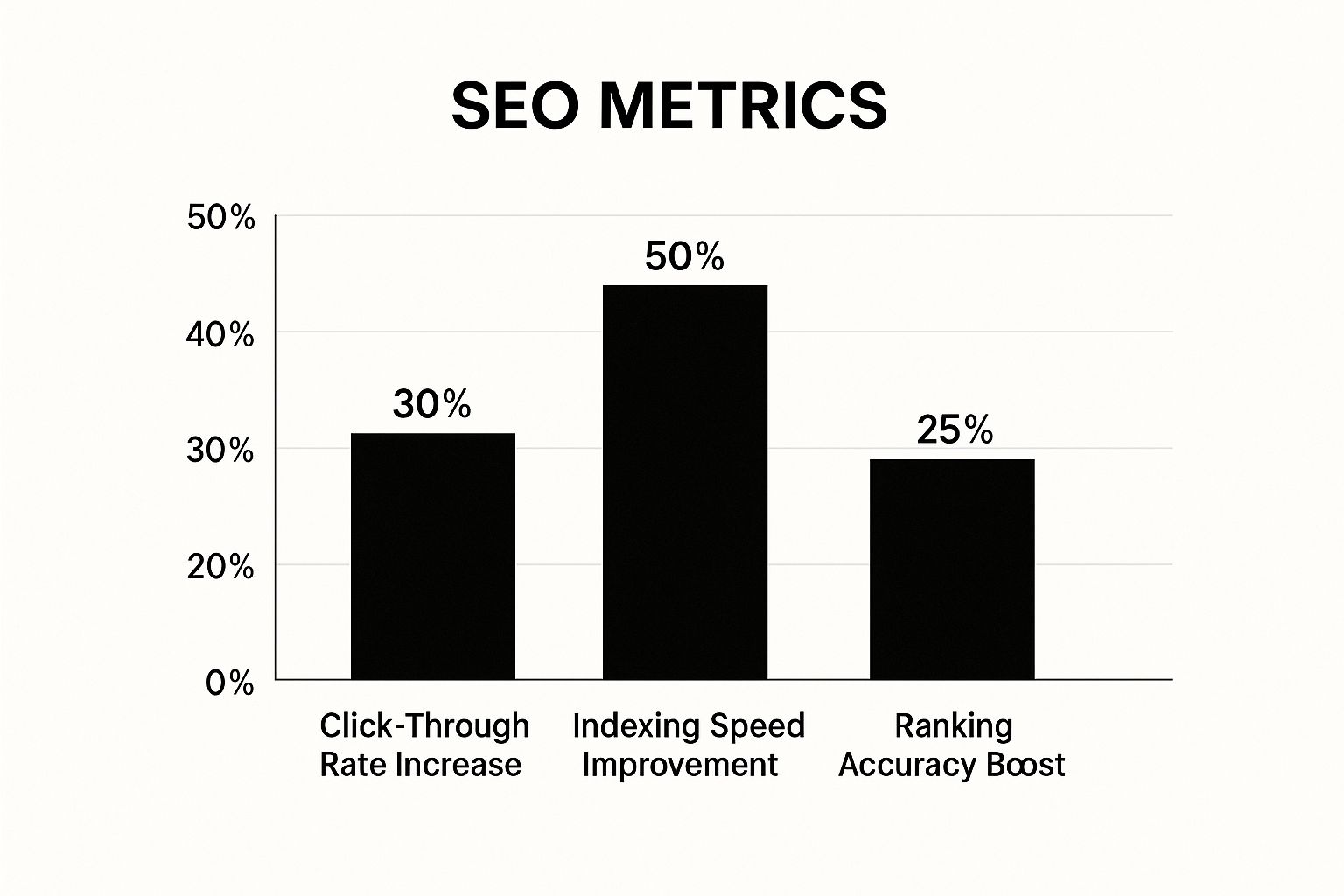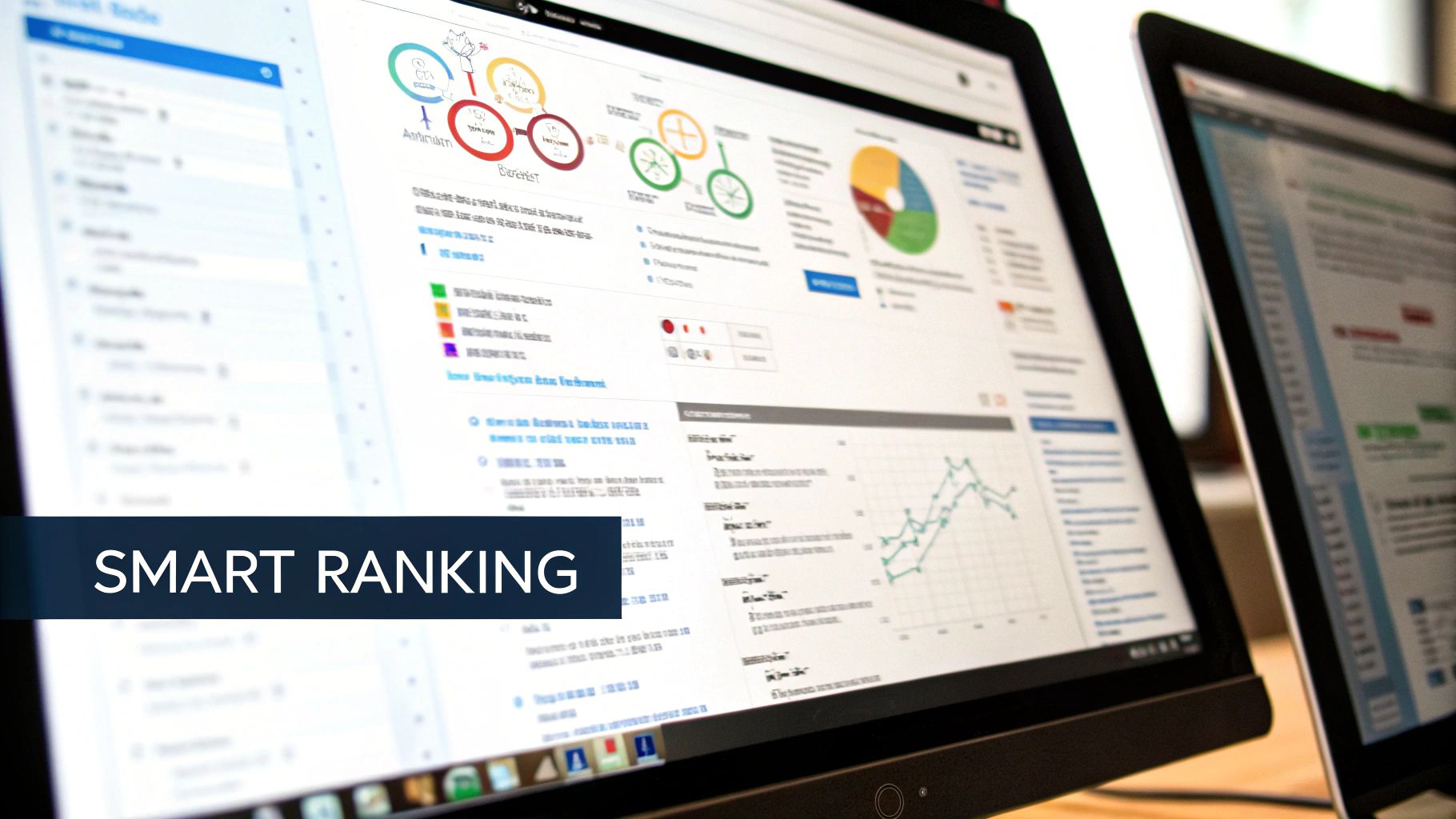AI Search Visibility: Proven Strategies That Drive Results
Understanding The New AI Search Landscape
The rise of AI-powered search engines is changing how people find information online. This shift requires a new approach to AI search visibility. Instead of focusing solely on keywords, the new search landscape prioritizes context. Understanding user intent and the relationships between words within content is now crucial. Optimizing for AI search involves more than just including keywords.
How AI Is Changing Search
AI algorithms analyze the meaning and relevance of content, not just the presence of keywords. For instance, if someone searches for "best Italian restaurants near me," an AI-powered search engine will consider factors like location, reviews, cuisine type, and even the time of day. This focus on context improves search accuracy and the user experience. The infographic below shows the positive impact of AI on key search metrics:

As shown, AI has led to a 30% increase in click-through rates, a 50% improvement in indexing speed, and a 25% boost in ranking accuracy. These improvements highlight the potential of AI to create a more relevant and efficient search experience. The search landscape's evolution has even impacted established players like Google. Though still dominant, Google's market share has dipped below 90% as of May 2025, facing competition from AI-powered and privacy-focused platforms. For detailed statistics, see StatCounter Global Stats.
Adapting to the AI-First Search Environment
To succeed in this new search environment, businesses must adapt their content strategies and embrace AI-driven optimization. This means creating high-quality, context-rich content that answers user queries thoroughly and naturally. Understanding natural language nuances and how AI interprets them is key.
For example, incorporating synonyms and related terms helps AI grasp the broader context of your content. This improves its ranking for relevant searches. Additionally, clear headings, subheadings, and bullet points enhance readability for both users and AI. Search engines can then understand and index information more easily. This improves AI search visibility and enhances user experience, boosting engagement and conversions.
To further understand the current search landscape, let's examine the market share of various search engines and their AI capabilities.
The following table, "Global Search Engine Market Share Comparison", presents current market share data showing the shift from traditional to AI-powered search platforms.
| Search Engine | Market Share % | Key AI Features | Target Audience |
|---|---|---|---|
| 88% | Knowledge Graph, BERT, MUM | General | |
| Bing | 5% | Semantic Search, Visual Search | General |
| DuckDuckGo | 3% | Contextual Advertising | Privacy-focused users |
| Yandex | 2% | MatrixNet, CatBoost | Primarily Russia and CIS countries |
| Other AI-Powered Search Engines | 2% | Natural Language Processing, Personalized Results | Niche audiences, specialized searches |
As this table demonstrates, while Google remains the dominant player, other search engines, including those with advanced AI capabilities, are carving out their own space in the market. This highlights the growing importance of adapting content strategies to the unique features of each platform. The rise of AI-powered search engines presents both challenges and opportunities. By prioritizing context, understanding natural language, and structuring content strategically, businesses can enhance their visibility and connect with their target audiences in the evolving AI-driven search landscape.
Regional Variations In AI Search Adoption
AI search adoption is evolving at different speeds around the world. This creates both obstacles and advantages for businesses aiming to be visible in AI search results. A successful targeting strategy must account for these regional differences to achieve maximum impact.
Privacy Concerns and AI Features Driving User Migration
Many factors influence user behavior, including privacy concerns and the availability of advanced AI features. Regions with strict data privacy laws, for example, might be slower to adopt AI search tools that gather significant user data. On the other hand, in markets with high tech literacy and a desire for new features, AI search adoption could be much faster. These different trends create unique user migration patterns across the globe.
In the United States, the search engine market share demonstrates this dynamic. Google still holds a commanding 86.83% share as of March 2025. However, Bing has grown to 7.56%, partly due to its AI features and integration with Microsoft products. Privacy-focused search engines like DuckDuckGo have also increased in popularity, claiming 2.23% of the market. Proceed Innovative explores this trend in more detail. The increasingly fragmented search landscape underscores the importance of customized optimization strategies.

Identifying Opportunities for Early AI Search Optimization
Finding geographic markets with high AI search adoption rates is essential for early optimization work. This allows businesses to focus their resources and gain a competitive advantage. These early adopter regions often offer valuable insights into user behavior and preferences within the AI-driven search environment.
These insights can then be applied to other markets as AI search adoption expands.
Tailoring Your Approach for Maximum Impact
Adjusting your strategy to each region's unique qualities is the key to maximizing ROI. This means adapting your content to local languages and cultural norms, addressing region-specific privacy issues, and highlighting AI features relevant to the audience.
For instance, in privacy-conscious regions, emphasizing data security and anonymity might be more effective than promoting personalized search features. Understanding these regional variations allows businesses to position their content effectively for AI search visibility in each market. This localized strategy also demonstrates a better understanding of user needs and preferences, strengthening the brand's connection with its audience.
Optimizing Content For AI-Powered Search Algorithms

Optimizing for AI search visibility requires a new approach. Keyword stuffing is no longer effective. Instead, focus on creating content that truly resonates with both AI algorithms and human readers. This means understanding how AI processes information and what it values.
Understanding AI's Priorities
AI-powered search engines like Google prioritize semantic understanding and user intent. They analyze the relationships between words to understand the context of your content. They then match this context to what the user is actually trying to achieve with their search.
For example, a search for "how to fix a leaky faucet" might yield results about different faucet types, required tools, and even repair videos. The AI understands the user's goal is to fix the leak, not just find information about "leaky faucets."
Structuring Content for Maximum AI Comprehension
To help AI understand your content, structure it logically and clearly. This benefits both AI and human readers.
- Clear headings and subheadings: These help AI identify the main topics and the flow of information.
- Bullet points and lists: These break down complex information into easily digestible pieces.
- Short paragraphs: These simplify information processing for AI and enhance readability.
Think of it like organizing a library. A well-structured system helps the AI quickly find and retrieve relevant information, boosting your content's visibility. Learn more about optimizing for AI-driven search in our article about How to master Generative Search Optimization.
The table below compares traditional SEO with AI-powered search optimization, highlighting the shift in focus from keywords to context and user intent.
To better understand the evolving search landscape, let's compare traditional SEO practices with the requirements of AI-driven search optimization. The following table summarizes the key differences and similarities:
| Optimization Factor | Traditional SEO Approach | AI Search Approach | Implementation Priority |
|---|---|---|---|
| Keyword Focus | Primary focus on keyword density and placement | Keywords still relevant, but focus shifts to context and semantics | High for Traditional, Medium for AI |
| Content Structure | Important for readability and user experience | Crucial for AI comprehension and information retrieval | High for both |
| User Intent | Considered but not always central | Central to matching content with user needs | High for AI, Medium for Traditional |
| Content Depth | Longer content often favored for keyword coverage | Comprehensive coverage of topic favored by AI for authority | High for both |
| Interlinking | Helps with site navigation and user engagement | Creates content ecosystems that demonstrate expertise | High for AI, Medium for Traditional |
As the table illustrates, while keywords still hold some importance, the focus has shifted significantly towards understanding user intent and structuring content for AI comprehension. Building a network of interconnected content is also vital for establishing topical authority in the age of AI.
Creating Content Ecosystems
AI prefers content ecosystems. This means building a network of interconnected articles and resources around a specific topic. This demonstrates expertise and provides comprehensive coverage.
This interconnectivity reinforces authority and boosts your content's chances of being recommended by AI. It's like building a detailed encyclopedia on your area of expertise.
Maintaining Sustainable Production Practices
While AI optimization is key, don't neglect sustainable content production. Prioritize quality over quantity.
Focus on creating valuable, informative content that truly benefits your audience. This builds trust and ensures long-term success. Stay updated on changes in AI search algorithms and adapt your strategies accordingly. This helps you maintain a strong online presence.
Leveraging AI Tools For Enhanced Search Performance
Savvy marketers are already using the power of AI to improve their search engine optimization (SEO). This isn't about replacing human creativity, but enhancing it with intelligent tools. Let's explore how AI can boost your search performance.
AI-Powered Tools for Keyword Research
Keyword research remains a cornerstone of SEO. AI can significantly improve this process. Tools like Semrush, Ahrefs, and Moz now offer AI-powered features. These features help identify promising keywords, analyze user search intent, and even forecast keyword trends. This allows you to target terms your audience actually searches for and anticipate their future needs.
AI can also uncover semantically related keywords that you might have overlooked, broadening your reach and boosting relevance.
Content Optimization with AI Assistance
AI is a valuable partner in content creation and optimization. Tools like Jasper and Copy.ai assist with generating content outlines, suggesting headings, and even drafting short-form content. The true power of AI, however, lies in its ability to optimize existing content. AI-powered tools can analyze content for readability, clarity, and keyword relevance. This ensures your content resonates with both search engines and readers.
This allows your team to focus on strategy and adding the human touch that truly connects with your audience.
Performance Analysis and Insights
Tracking and analyzing performance is essential for improvement. AI-driven analytics platforms provide deeper insights into user behavior, keyword performance, and content effectiveness. They can pinpoint areas for improvement, measure the effectiveness of AI-assisted optimization, and predict future search trends.
This data-driven approach enables more informed choices and a more responsive search strategy. AI can also find patterns and correlations that might be missed by traditional methods, revealing hidden opportunities. The AI content marketing industry is projected to reach $2.4 billion in 2023 with a CAGR of 25.68%. This growth highlights the significance of AI in search visibility. Learn more at SEO.com.
Integrating AI into Your Workflow
Successfully using AI requires a strategic approach. Don't simply apply technology without a plan. Instead, determine specific areas where AI can enhance your current workflows. For instance, use AI for initial keyword research and content outlines, but let human writers create engaging narratives and ensure accuracy.
This combined approach optimizes the advantages of AI while maintaining the human element. Also, define clear metrics to assess the impact of AI on search performance. This data-driven method validates investment in AI tools and allows you to refine your strategy over time.
Building a Long-Term AI Search Visibility Strategy

Achieving and maintaining strong AI search visibility takes a strategic, long-term plan. Instead of chasing quick wins, concentrate on a sustainable system for consistent results. This means developing a robust content ecosystem that works well with AI algorithms.
Creating Interconnected Content Networks
AI algorithms prefer content showing expertise and authority. One way to demonstrate this is by building an interconnected content network. This involves creating linked articles, blog posts, and resources covering a topic in detail. Think of it like building a niche encyclopedia.
For example, a software company might create a content cluster around project management. This cluster could cover topics from basic methods to advanced integrations with software like Jira. This interlinked structure helps AI grasp your knowledge depth while offering valuable resources to your audience.
Staying Ahead of Algorithm Updates
AI search algorithms constantly change. To maintain AI search visibility, anticipate and adapt to these updates. Continuously monitor algorithm changes and new AI search features. This proactive approach helps you adjust before competitors do.
Stay informed about industry trends, attend conferences, and engage with the AI search community. Tools like those listed in Best Generative Search Optimization Tools can help. Experimenting with new AI-powered SEO tools can also offer insights into emerging search trends and refine your optimization strategies.
Measuring Long-Term AI Search Performance
Measuring your AI search strategy's effectiveness requires a unique approach. Traditional SEO metrics are still useful but need AI-specific indicators. Analyze factors like content relevance, user engagement within AI search environments, and how often AI platforms recommend your content.
Understand how AI assesses content quality and user satisfaction. For example, track how users interact with your content after finding it through an AI-powered search engine. Are they staying longer, exploring other pages, or taking desired actions? These data points can reveal early signs of success or areas for improvement. Also, monitor the sources AI platforms cite to find content gaps and build stronger topical authority.
By incorporating these strategies into your long-term plan, you can create a robust and adaptable system for sustainable AI search visibility. This sets you up for continued growth and success in the evolving world of AI-driven search. This proactive approach, with continuous monitoring and optimization, keeps your content relevant, engaging, and easily found in the dynamic AI search world.
Measuring And Improving Your AI Search Results
Understanding what works in AI search requires new metrics and measurement approaches that go beyond traditional analytics. Forget simply tracking keyword rankings and click-through rates. Instead, focus on how AI interprets and interacts with your content. This means examining the context, relevance, and authority of your content within the AI search ecosystem.
Key Performance Indicators for AI Search Success
Traditional SEO metrics still hold some value, but achieving AI search visibility demands new KPIs. These new KPIs focus on how effectively your content resonates with AI algorithms.
- Content Relevance: How well does your content align with user search intent within the AI environment? This means understanding how AI interprets search queries and matching your content accordingly. For example, someone asking an AI for "best productivity apps" might want more than a simple list. They might also be seeking features, pricing comparisons, and user reviews.
- AI Engagement: This KPI measures how users interact with your content after accessing it via an AI search platform. Are they staying on your page? Exploring related content? Taking desired actions? High AI engagement signals to the algorithm that your content is relevant and valuable.
- Content Authority: This refers to how often AI platforms recommend your content as a reliable source. Higher authority leads to increased visibility and positions your brand as a thought leader. Building this authority requires creating high-quality, interconnected content within a broader ecosystem.
Tracking AI Search Performance Effectively
You might be interested in: How to master AI SEO. Effectively tracking these new KPIs requires specialized tools and strategies. Platforms like Sellm are designed specifically for monitoring GEO and brand visibility in AI environments. This allows you to analyze how LLMs, such as ChatGPT and Claude, are interacting with your brand and content.
Additionally, analyze user behavior within AI search environments. For instance, if users consistently click through to your content from an AI summary, but then quickly leave, this indicates a relevance problem. Your content might not be delivering on what the AI promised in its summary.
A/B Testing and Optimization for AI Algorithms
A/B testing is essential for optimizing content for AI. Experiment with different content structures, language, and formats to determine what resonates most effectively with both AI algorithms and users.
This could mean testing clear headings and concise summaries against longer introductions and more complex sentence structures. Analyze the results to understand which format leads to better AI engagement and higher visibility.
Optimizing Based on User Behavior Patterns
User behavior patterns within AI search environments offer invaluable insights for optimization. Track how users find your content, how long they stay, and what actions they take. This data helps you understand what's working and adapt your strategy accordingly.
For example, if users primarily discover your content through AI summaries, but don't click through to your site, it suggests your summaries aren't compelling. Alternatively, if they click through but quickly leave, it might indicate a content quality or relevance issue on your landing page.
By analyzing these patterns and utilizing tools like Sellm, you can continuously refine your AI search strategy and improve your AI search visibility over time. These data-driven insights enable more informed choices about content creation and optimization, ensuring your content connects with both AI and your target audience.
Future-Proofing Your Search Visibility Approach
The AI search landscape is constantly changing. To maintain strong AI search visibility, you need a flexible, future-proof approach. This involves anticipating changes, adapting quickly, and continuously improving your skills and knowledge.
Adapting to the Evolving AI Search Landscape
AI search algorithms and features are constantly being refined. Building adaptability into your strategy is crucial. This means staying informed about updates and being prepared to adjust your approach as needed. For example, if a new AI search engine prioritizes video content, you should be ready to incorporate video into your content strategy. This flexibility allows you to capitalize on new opportunities.
Think of your strategy like navigating a ship – you need to constantly adjust your course to account for changing currents and tides in the search landscape.
Developing Essential Skills and Knowledge
Staying ahead in AI search requires continuous learning. Focus on developing key skills such as understanding Natural Language Processing (NLP), Semantic SEO, and AI-driven content optimization. These skills help AI systems understand and value your content.
Additionally, keeping up with emerging AI technologies and search trends will ensure you're prepared for any shifts in the AI search landscape.
Staying Informed About AI Search Evolution
Staying informed requires proactive effort. Follow industry blogs like the Sellm blog, attend conferences, and participate in online communities focused on AI and search. These resources provide valuable insights and best practices on AI-powered search optimization and emerging trends.
Actively experimenting with new AI tools and features is also important. This hands-on experience will deepen your understanding of how AI search works and how to optimize for it.
Preparing Your Search Strategy for the Future
Future-proofing your search strategy involves creating a robust foundation. Focus on building a strong content ecosystem that demonstrates expertise and authority. This interconnected network of content provides value to both AI and users, boosting long-term visibility.
Also, establish clear benchmarks for measuring AI search performance. Tracking relevant metrics like content relevance, user engagement in AI environments, and the frequency of AI recommendations helps you understand what's working and what needs improvement.
By developing these skills, staying informed, and building a strong foundation, you can confidently navigate the evolving world of AI search. Ready to boost your brand's visibility? Sellm.io specializes in GEO and brand monitoring within AI environments, optimizing your presence in responses from LLMs such as ChatGPT, Claude, and Perplexity. Visit Sellm.io today to learn more.